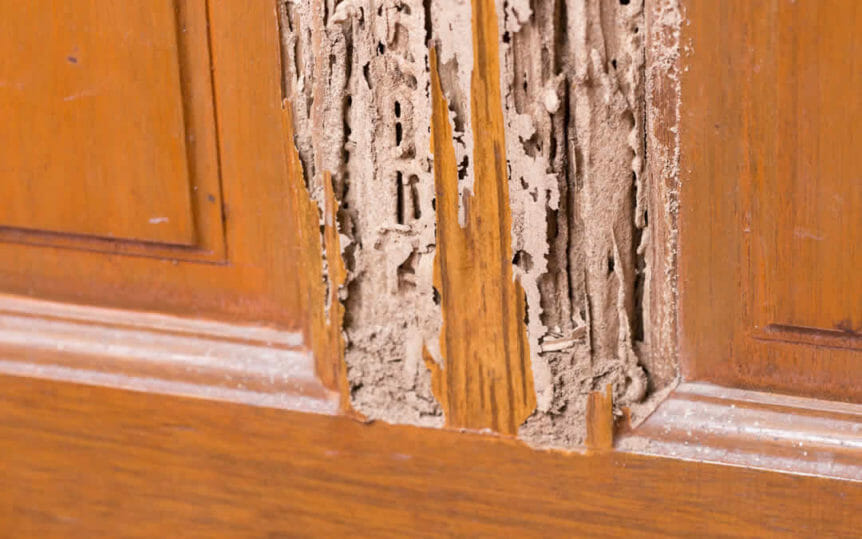
Eaten From the Inside Out: The Problem With Termite Damage in Southeast Texas
As a homeowner, you face countless concerns regarding home protection. Not only do you have to think about personal security, but you’re also faced with worries regarding the security and stability of your home construction. Is your home being eaten from the inside out? Unfortunately, termites are a prevalent problem in Southeast Texas, one that thousands of homeowners face each year. Included here are a few things you should know about termite prevalence and how to prevent/treat termites in your home.
Know Your Enemy
The first step in dealing with any kind of pest problem is knowing what you are up against. Termites are an incredibly small, and difficult, pest that can create a whole host of problems if you’re unprepared. Let’s begin by taking a look at these tiny, but terrible, insects that resemble a white grain of rice.
While there are more than 2,000 different termite species worldwide, only 50 varieties are found in the U.S. The type of termite you are up against depends on your geographical location. Unfortunately, in Southeast Texas, all three of the most voracious termite species are found: Subterranean, Drywood and Formosan.It takes 2-4 years for a termite colony to develop to maturity. At full maturity, the termite colony will proceed to cause destruction to your home at an ever-increasing rate. While the termites will not
It takes 2-4 years for a termite colony to develop to maturity. At full maturity, the termite colony will proceed to cause destruction to your home at an ever-increasing rate. While the termites will not swarm in winter, the warmth of your home allows them to remain active and eating, even in the colder months.
The lifespan of a termite is something to take into consideration. While the majority of working termites only live to be 1-2 years old, they reproduce at a rate of potentially thousands per day. In some species of termites, the queen can live to be 25-50 years old! That means once the colony has arrived, it’s likely not leaving, except by force.
Termites are a wood-eating insect, but the amount of damage they do depends on the climate, type, wood condition, alternate food sources, and the size of the colony. In an ideal climate, a Formosan termite can cause significant damage to a home in only 6 months. With the yearly cost of termite damage hovering around $30 billion, it is safe to say these insects are costly.
Prevention Methods
The average homeowner who discovers a termite problem will face damages of $3,000 on average. In Southeast Texas, you face a dangerous dynamic trio of termites and must be prepared to prevent their colony establishment. The average termite colony can consume 2.3 linear feet of 2×4 pine in one year alone. If that doesn’t sound damaging, consider losing 2.3 feet of a supporting beam of your home!
Often, the key to treatment lies with prevention. With how rapidly termites reproduce, prevention is often the wisest course of action. Take the time to consider your home environment and whether you are sending out a welcome signal to these insidious pests.
Termites are constantly searching for food sources and you may inadvertently be providing them. While mulch is a great moisture sealer for the garden, it provides wood and water to hungry termites. Keep mulch away from the walls of your home. Additionally, do not leave scrap lumber or firewood close to the base of your house.
Termites will need some water source to survive, so be cautious about the dampness of your home. A leaking pipe or burst water line can attract termites, as they love to dine and drink at the same place. Heavy brush around your home can also provide a source of liquid nourishment to termites and should be removed or pruned.
Keep in mind that termites can enter your home through the smallest entryways. A gap smaller than a dime could serve as an open door to termites. Examine your home for cracked or peeling paint as well as foundation cracks. By keeping these spaces covered and filled you can prevent termites gaining access at all.
Signs of Infestation
Now after being scared silly by the threat of termites, you’re probably wondering if they’ve already seeped into your seemingly safe home. While you may think ignorance is bliss, you genuinely need to know about termite presence before it significantly damages your home. The sooner you treat for termites, the less you face in damage costs.
Termites prefer to occupy dark, humid spaces, so they do not typically eat the exterior of a wooden beam. They will literally eat your home from the inside out, and a piece of stable looking wood could actually be quite hollow inside. Try knocking on wooden supports or beams around your home to see if any of them sound hollow.
Signs of a termite swarm can be found in discarded wings. A heavy presence of winged insects near your home’s foundation, or a pile of discarded wings could mean the enemy has landed. Subterranean insects prefer to live in the soil outside your home and develop mud tubes for transportation. Visible mud tubes on your home’s foundation can be an obvious warning bell.
All of that wood has to go somewhere, and the excrement of termites can be another telltale sign. The feces of Drywood termites is called “frass” and looks like a tiny wood-colored pill. Keep in mind, those tiny pill sized poops are smaller than 1/10th of a penny, so you will have to have sharp eyes. The frass is usually left in piles, though, so before you write it off as dirt, make sure it is not a more sinister sign.
Eradication Methods
After all of this talk of termites, you might be wondering what to do if you actually find them. Eradication methods for termites can be exceedingly varied, but most involve calling in a professional. Professional termite eradication teams will be able to determine what species you are fighting, and therefore, can utilize the most effective treatments.
If you believe your home is under attack from these insidious insects, contact John Moore. We will eradicate these pests and have your home safe and secure as soon as possible!
